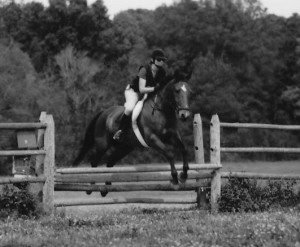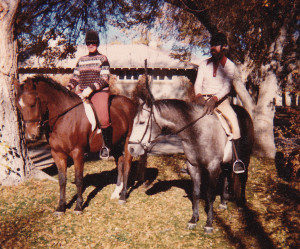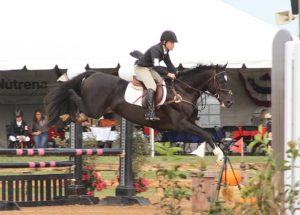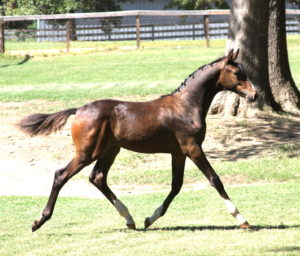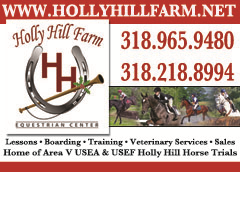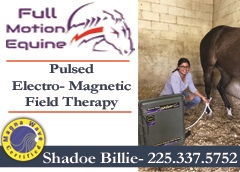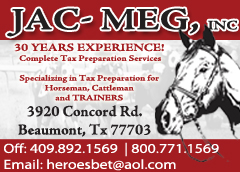Written by Barbara Newtown
Original Publish Date December 2013
When people who knew me way-back-when reconnect, they ask: “How did you end up in Louisiana…with twenty-one horses?”
I married a horse-crazy man.
George Newtown was seven years old when horses took over his dreams. His family was living at Camp Pendleton in Southern California, where his dad, a Marine warrant officer, was stationed. They attended an exhibition on base and watched Champ Hough, a Marine corporal recently returned from the Olympics, show off his jumping skills. Champ had a broken arm in a sling and he and his black horse jumped a Cadillac. Champ said he would give riding lessons to kids for fifty cents an hour, and George signed up.
When George’s dad was sent to Vietnam, he found acreage for his family near Fayetteville, Arkansas, and bought them a Missouri Fox Trotter to keep them occupied while he was away. Then George’s brother won a horse at the fair; George’s mother Vera adopted a small, unwanted, unregistered Quarter Horse mare; the fair horse proved to be pregnant… and the menagerie increased even more when Vera started breeding the little QH mare to stallions from good neighborhoods. Her breeding philosophy: “Yum Yum’s in heat—who owns a stallion?”
Vera was horse-crazy, too, and didn’t mind hauling George around to compete in Western Pleasure, saddle seat, hunter, and gaited shows. George’s brother Glen was not horse-crazy, but he knew that inviting girls over for a trail ride was a winning gambit.
George’s dedication to horses kicked into a higher gear when he spent time in Germany to learn German, take a break from graduate school in Comparative Literature, and study dressage and jumping. He returned to the States to finish up at Yale and hit the job market. He also acquired an Argentine Thoroughbred who had extravagant movement over cavaletti. Studying in Germany had convinced him that he had to standardize and upgrade his horses, but finding a good warmblood in Arkansas in the 1970s was impossible. Meanwhile, his mother kept breeding the little Quarter Horse to “stuff”—some Arabs, a Fox Trotter, a Thoroughbred. George, on the other hand, found the perfect match for his TB mare: Fixture, a Bold Ruler grandson with excellent movement. He started his own breeding program, with the goal of producing an event star.
George’s last year at graduate school was my first. I had come to Yale to study music history and theory. We met at a Danforth Fellows meeting and hit it off instantly—within five minutes I was thinking he was The One, and years later he told me that he had thought the same about me. But we held back, because his professional life was about to start and mine was years away. Who knew where he would be when I was done…or where I would find my own job?
After four years I was an expert in Renaissance choral music and Beethoven’s compositional process. I had an unfinished dissertation and no job prospects, so I returned to Oregon, where my parents had recently bought a small cattle ranch in the Coast Range. George had finagled a job at the University of Arkansas and was able to live at his parents’ farm and school his horses. We connected again after he sent me a cute picture of a horse baby and we started writing to each other several times a week (remember, this was way before email!). Then we started having two-hour phone calls (long-distance charges!). We visited back and forth: his parents’ new retirement ranch, my parents’ new retirement ranch. Oddly, both of our fathers had retired early in the same year: his from the Marines, mine from Boeing. Both sets of parents wanted to “get back to the land” and be their own bosses, and both farms supported about 100 cow-calf pairs and a couple of bulls.
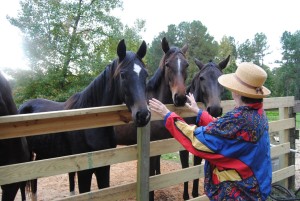 No horses on our ranch, though. My father herded his cows by calling the lead cow by name and showing her the open gate.
No horses on our ranch, though. My father herded his cows by calling the lead cow by name and showing her the open gate.
If I hadn’t married George, I would probably be a yacht broker in New York, or a music history professor at a small college, or a ski instructor in the Cascade Mountains, or a folk singer, or a barista with an unfinished novel. But George was The One…and I realized that he wasn’t about to learn the guitar or buy a boat or wish for snow. To George’s credit, he knew that asking me to embrace a lifetime of horses as well as a lifetime of him was a tall order. So, before we were married, he prepared me for the big step by giving me a two-year pile of Practical Horseman and a slim book he called the Bible of riding: Reitlehrer by Müseler.
“You can read the English version, if you insist,” he said. “Riding Logic.”
He also told me that my wedding present was a lifetime of riding lessons—from him.
Flash forward a few months to when we’re newlyweds, just back from our honeymoon and getting used to living as a twosome in Birmingham, Alabama. George had tired of departmental politics and had lost his zeal to be a professor. We hatched a wacky plan to become opera directors (George and I both had theater skills, and he had sung bass opera roles.). We acquired seven part-time jobs to support our unpaid internships with the Birmingham Civic Opera. (Seven? Yes: we both directed Methodist church choirs, we both got paid for singing in the opera chorus, I taught guitar, and we both taught part-time at the University of Alabama in Birmingham: German for George, music history and theory for me.)
I, fully committed to George and horses and now armed with excellent theoretical training, encouraged him to bring from Arkansas his half-Arab half-Quarter Horse Zam Zam, whom he had been training in dressage and eventing. (The Thoroughbred babies weren’t ready yet.) We set Zammy up at W** H*** Stables, the only boarding facility in our price range. Lots of barbed wire and mud.
The first day we “went to see Zammy” I discovered that I was allergic to horses. Weeping and itching, I still persevered in learning how to brush him, pick sticks out of his tail, poke around in his feet, and wipe glop out of his eyes. George put on Zammy’s dressage saddle and dropped-noseband snaffle and we walked out to a bumpy field. I sat under a tree. It was over 100 degrees. George and Zammy went in circles and straight lines at various speeds.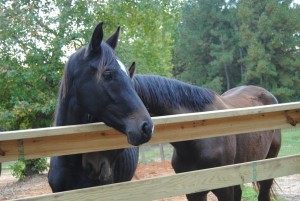
“You aren’t watching!!!” George yelled. That was true: I was sleeping. “You missed our shoulder-in!” I quickly learned that shoulder-in going away from my tree gave me 15 seconds of shut-eye. Soon George and Zammy were done, Zammy had his bath, we loaded our tack and cleaning gear back into our creaky Volkswagen, and we took off for our Saturday opera rehearsal.
“We’ll come out tomorrow after church,” said George. “Weekdays we can get here first thing in the morning.” I can’t describe the despair and panic I felt. I thought riding was something you did on Saturday. Worse was to come: Zammy contracted “race track cough” (thank you, W** H*** Stables) and we had to “go to the barn” every eight hours to pour Dantafur down his throat. The barn was 45 minutes from our apartment. They say that the first year of marriage is the hardest, and they are right.
A year later, after riding every day, attending numerous church potlucks, combining our church choirs for Christmas and Easter extravaganzas, and weathering Madama Butterfly, Amahl and the Night Visitors, Don Pasquale, and Il Trovatore, we had added two more jobs: we both (yes, both of us!) taught jumping and dressage at Shoal Creek Equestrian Center. Part of our pay was free board for–now—two horses: Zammy and his half-brother Rocco, also an Arab/QH blend. Several times a month George and I attended or audited lessons (Ann Ticehurst, Denny Emerson, Melanie Smith, Charles de Kunffy, Michael Poulin, Lendon Gray, George Morris), showed in dressage or hunters, or evented (dressage, cross-country jumping, and stadium jumping).
What did I learn about riding that first year?
- Keep brushing the horse, and your allergies will fade.
- Don’t talk during a lesson. Just do it. If the instructor says, for instance, “Stop hanging on the inside rein,” move your inside hand six inches forward so that there is a loop in the rein. If it’s too much, the instructor will tell you. More likely, the instructor will be thrilled to have such a good student.
- It’s ok to have butterflies—just make sure they fly in formation. (Thank you, Denny Emerson!)
- This sport is expensive and dangerous, so pay attention! (Thank you, George Morris!)
After two years of the opera world, George and I decided we wanted to return to our roots: full-time academe. Coaxing tenors, painting scenery, schmoozing with donors, and chasing down props made us eager to return to the world of ideas. We saw an ad in The Chronicle of Higher Education: “Deep Springs College, a small, two-year, all-male honors college, located on a cattle ranch in the high desert of Eastern California, seeks faculty to teach a variety of courses. Couples are encouraged to apply.” George and I saw three key words: ranch, honors, and couples. When the President of Deep Springs called to offer us the job, George asked for room and board for four horses. “Sure!” said the President.
Our six years at Deep Springs were intense. The college is isolated in a 12 x 4 mile flat valley bordered by the peaks of the White Mountains. Surrounded by sage, cactus, and lots of sand, the college nevertheless has exclusive rights to all water under or coming into the valley. The three hundred cow-calf pairs and the ranch horses are fed irrigated alfalfa hay. Lush lawns surround staff and faculty houses, the boarding house, and the main building with its dorm wing, library, and administrative office. When we were there, in the 1980s, there was no TV reception and only one telephone line for the entire community. (In fact, Deep Springs was one of the last locations in the USA to use a hand-crank telephone.) Everyone lived on campus: eight faculty; the President; six staff including a ranch manager, college secretary, and cook; various spouses; and twenty-four students. Bishop, California, location of the nearest hospital and grocery store, was an hour away, over twisting, steep Westgard Pass. Boulders and snow regularly blocked our way out. (Type “Deep Springs College, CA” into maps.google.com; you will see the bleak mountain valley and the impossible greenness of the campus.)
Academics at Deep Springs are rigorous. We chose our students from the top 1% of SAT scorers in the nation. Every student receives full tuition, room and board. At the end of their two years the students transfer to schools like Cornell, U. of Chicago, Berkeley, or Harvard.
Deep Springs is unique because, in addition to the rigor of the academic program, the students are also the “beneficial owners” of the ranch and college. They have tremendous responsibility and power; they supply 90% of the committee memberships and 100% of the ranch labor. For example, the students grow all the vegetables for the community, slaughter the cows, pigs, and chickens, milk the dairy cows, castrate and brand the calves, and shoe the horses. Faculty and staff offer guidance, not decrees. And the students govern their own behavior. The upshot? Students leave Deep Springs with tremendous confidence and independence. The downside is that when Deep Springers make mistakes, they are huge: letting 5,000 gallons of diesel drain out into the desert, for instance. (The student who let the diesel out actually became a success: twenty years later, he became a recipient of a MacArthur Fellowship, the famous “genius grant.”)
At Deep Springs, George and I taught French, German, English, dramatic literature, chorus, Freud, music history and theory, composition (English and music), and interdisciplinary courses like “Scientific Revolutions,” “Work and Community,” and “Beethoven and Creativity.” We also directed such plays as “The Elephant Man,” “Terra Nova” (about Scott’s disastrous trip to the South Pole), “The Bald Soprano” (in French), and “Zoo Story.”
Our four horses—Zam Zam, Rocco, and two Thoroughbreds—settled in nicely with the ranch horses and learned to love alfalfa.
Barbara & Zam Zam and George & Rocco at Deep Springs:
We borrowed a little tractor and blade to scour the sage off the desert and create room for a full-size dressage arena and room for jumps. George did his own shoeing and acquired a lifelong admiration for anyone who makes a living that way. We conditioned our horses by trotting uphill along sandy streambeds or doing gallop/walk intervals straight down the valley for miles, jumping sage and skirting prairie dog villages. Once I even got stuck in quicksand deep enough to cover the saddle and terrify my horse; I grabbed a branch of sage to pull myself out, and hauled the horse to me with the reins. When he hit solid ground he practically jumped into my arms; he trembled and needed a lot of patting to calm down.
One time we trotted up a stream bed to a “saddle” between two peaks. We stood placidly for a bit, admiring the valley stretched out below…and then we heard a jet engine coming up behind us. George and I knew instantly what it was: an F-15 from Nellis AFB, practicing subsonic attack strategy, hotdogging from valley to valley through the White Mountains at very low altitude. There wasn’t time to get off or seek a lower elevation. We were surrounded by rocks. We both thought, in the microsecond left to us, “When our horses catch on to this, we’re going to die.”
The F-15 passed overhead so close that we could see rivets on the fuselage. The roar was horrendous. And our horses, Zam Zam and Rocco, didn’t even notice. We formed a theory: Things that frighten humans are too big for horses to contemplate. The corollary, of course, is that hoses and black plastic will turn a horse upside down.
Finding places to show meant driving at least six hours north to Reno or south to Las Vegas—or even to Los Angeles—but we did it. During our summers off we would head up to Oregon to stay with my parents, and hit all the dressage shows and events between Eugene, Portland, and Bend. We also were trying very hard to sell the Yum Yum progeny. Despite their “mutt” breeding, those little horses had wonderful traits: rock solid feet, good natures. In fact, Yum Yum’s last colt, Overtime (we called him Timer), who joined us at Deep Springs after a couple of years, turned out to be a gem: his sire was an Oklahoma Thoroughbred, and Timer looked—and moved—like a perfect 15.1 warmblood. (“Mom finally got it right,” said George.) We sold him to a woman in Portland. Twenty-five years later she wrote to us and said that Timer had just passed on, at the age of twenty-nine, and that he was the best friend she’d ever had and he had never taken a lame step.
The students were mystified by our insistence on “riding English.” They said, “You’re on a ranch! You should ride like ranch hands!” We took them up on their challenge and joined the fall cattle drive. We and six other riders—two other faculty, the ranch manager, and the student cowboys—followed a time-honored trail up to 10,000 feet, to the alpine pastures where the Deep Springs cows had spent the summer. We camped at “Cow Camp,” a shack with a wood stove and wallpaper made of newspapers. Refrigeration meant submerging butter and milk in a crystalline mountain stream. In the morning, after a shot of boiled coffee and a lot of scrambled eggs and potatoes, we rounded up the 300 cows and the calves they’d had during the summer and started pushing them down 5,000 vertical feet along the arroyos to Deep Springs Valley.
Dressage and jumping training is excellent prep for a cattle drive. George and I had on our tall boots, which meant that we didn’t mind squeezing through sage bushes. Our horses wore jump saddles, which meant that we could take off after a stray and just let our horses gallop and jump (sage, rattlers, streams) as we stayed off their backs in two-point position. Our horses could leg-yield around boulders and serpentine through bushes. Our dressage whips were the perfect length for tapping slowpoke cows on the butt. Our mounts for the drive, Rocco (mine) and Timer (George’s), were textbook cases of what it means to have, or not have, “cow.” Rocco clued in very fast to what we were trying to do. Slow cows were an affront to him—so much so that he’d reach out and bite them on the rear end. When a cow made a break, Rocco noticed instantly and said, “Let’s get ‘im!” He was interested and joyous every step of the way. Timer, on the other hand, saw the herd as a dusty, swirling giant amoeba that could reach out and get him. He never focused on an individual cow. He was exhausted when we finally got back to the ranch. Timer was still useful, though, walking alongside the herd and making a psychological barrier for the cows.
No one is allowed to stay at Deep Springs very long. The Board of Trustees knows that life there is too pressurized for a normal existence. It’s difficult for families: the nearest school is in Bishop, and little kids at the college don’t have playmates. Most faculty stay three to five years; George and I stayed six, by which time we had a little girl, Elizabeth. By then we were ready to move on…but to what? George figured the only way we could afford to stay horse people was for him to enter academic administration. He had been functioning as Dean of Deep Springs, and decided to use that inflated title to make his way into a more conventional job.
We moved to Wausau, Wisconsin, where George became chief academic officer at the University of Wisconsin Marathon Center, a selective, two-year college that fed students to the Madison campus. We sunk our retirement funds into buying a 40-acre defunct dairy farm with a classic American Foursquare farmhouse, complete with widow’s walk around the central chimney. We put up a cute indoor arena/barn building, with hay storage, tack room, and four stalls. We waited for winter.
Well, our time in Wisconsin taught us some lessons: George hates administration. Even if you have an indoor arena, in the winter you still experience fierce subzero wind chill when you trot. Asthma (poor Elizabeth!) can be triggered by cold air. It’s so hard to keep fit in the winter that you overdo it in May and your horse goes lame for the summer.
My career fizzled out. I couldn’t find a position in my particular field within five hundred miles of Wausau…and even if we had been able to manage a “commuter” marriage, taking care of our chronically sick daughter would have moved me to quit, anyway.
Good things did happen in Wisconsin, though. By now we had two daughters out of George’s original TB mare: Nancy Whiskey and Handsome Molly. We decided to start breeding warmblood/TB mixes; we wanted steadier temperaments and even better gaits. We chose Frohwind, a young Oldenburg stallion with great Selle Francais jumping blood on his top line and Hanoverian on the bottom. Before we left Wausau, we had two Oldenburg foals: Holly Golightly and Finnegan. We followed the naming system used by some Oldenburg and Trakehner breeders: fillies use the first letter of the mare’s name; colts use the first letter of the stallion’s name. Thanks to Nancy Whiskey and Handsome Molly, almost all of our fillies these days start their names with N or H…Natalie, Norma Rae, Norma Jean; Harmonie, Hermione, Hannah, Hattie, Hildegard, Hippolyta, Honor, Hayley, etc., etc.
After three years as an administrator, George applied for a straight teaching job. His criteria: warm weather, affordable land, small liberal arts college. Centenary College in Shreveport, Louisiana, was interested, and we waved goodbye to winter. Our Wisconsin place took another three years to sell. We ended up taking care of a horse farm south of Shreveport for one of Centenary’s trustees; he and George would go for gallops between the cotton fields every Saturday morning. We continued our warmblood breeding program, through artificial insemination, with Dr. Robert Hewlett of Benton, Louisiana.
One day, when I was hospitalized with premature labor while carrying our son-to-be David, George took Holly up to Benton for a pregnancy check with Dr. Bobby. “I’m sorry,” said Bobby, “she’s not in foal.” George stood there feeling very dejected—my mare’s open, my son might be in danger, I live in a trailer—when all of a sudden a woman appeared and said, “Bobby, I want to sell my place and move to Springhill.” Bobby immediately turned to George and said, “Go look at their place next door. I want you as a neighbor!” George looked, and fell in love with the cute barn, paddocks, tall pines…but not with the house, which was a drab ranch which hadn’t been redone since the sixties. “Oh, Barbara will hate this,” he thought. With great apprehension he sprung me from the hospital and took me out to Benton. I looked at the house, which had good bones—crack-free walls, thick slab, four-foot overhangs—and decided that all it needed was paint, rugs, and appliances. The barn and trees and fences were great. From my fact-finding with the geologists at Centenary, I knew that the Benton footing was excellent: sandy, that is, not the boot-grabbing clay of south Shreveport. And the location was to die for: next door to Holly Hill Farm, the best dressage-and-eventing facility for hundreds of miles in all directions.
With Dr. Bobby’s help, our Oldenburg NA breeding operation has prospered. We now have six broodmares, including newcomers Zoe (a Dutch Warmblood by Juventus) and Weltkin (a Hanoverian by Weltmeyer). We hope they have daughters soon: we want to start using Z and W names! The “N” line ended with beautiful Norma Jean, who had only one foal before she died: the colt Balanchine, by the Hanoverian dressage horse Bergamon. When Balanchine hit the ground, George and I had the same thought: Nice enough to be a stallion! Our second thought: He is far enough removed to breed our “H” line broodmares! (The ISR/Oldenburg organization has recognized our farm for having one of the longest mare lines in the USA.)
Balanchine is now seven, and his first three crops have yielded plenty of premium foals. In fact, this year five of his seven Newtown Farm babies were awarded premium! The national average is 25%. Ashlea Trosclair, professional rider and trainer, will be showing Balanchine (and his uncle Fiorello) at horse trials next year.
Ashlea & Balanchine:
And Bobbie Burns, one of Balanchine’s premium foals:
Our human babies are doing well—Elizabeth is studying criminal justice, and David will soon go off to college, with thoughts of chemistry and music. (Update: Elizabeth and her husband Eric are Special Education teachers and have a daughter Robin; David is studying geology and cello at Columbia in NYC.)George is happy teaching. He recently received a letter from a former student, thanking him for his imaginative classroom techniques and his care with students’ essays. Much like the letter from Timer’s owner, it brought tears to his eyes… It’s nice to be able to make a difference.
As for me…I satisfy my musical desires by singing in a fine choir, studying bluegrass banjo, and taking joy in David’s cello playing. Oddly enough, my training in musical analysis and historical research did wonders for my writing. Before graduate school, my writing efforts were too artsy; in graduate school I learned how to write clearly. I am working on a young adult novel these days…a horse is a major character, of course. My favorite riding experience since coming to Benton has been performing in a quadrille (a choreographed dressage ride for at least four horses). And my most triumphant display of riding occurred at the end of a trail ride at Holly Hill, when my horse stepped on an underground bee nest—and I stayed on. Look for me in the future on Hattie (Festrausch x Holly Go Lightly), currently being trained by George.
One day I was sitting at home not writing…and an SUV drove up. It was Mike Milazzo, selling ads for his new magazine, The Louisiana Equine Report. We talked a bit, and he said he was always looking for good copy. Something made me say, “You need me.” I started doing articles for the Report and I am having a darn good time doing it.

